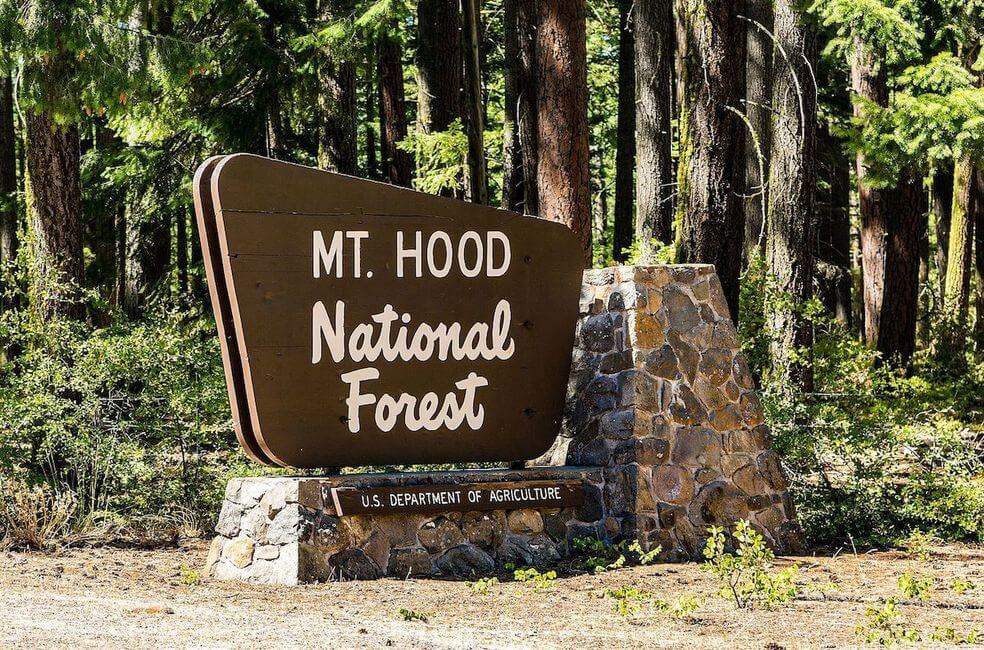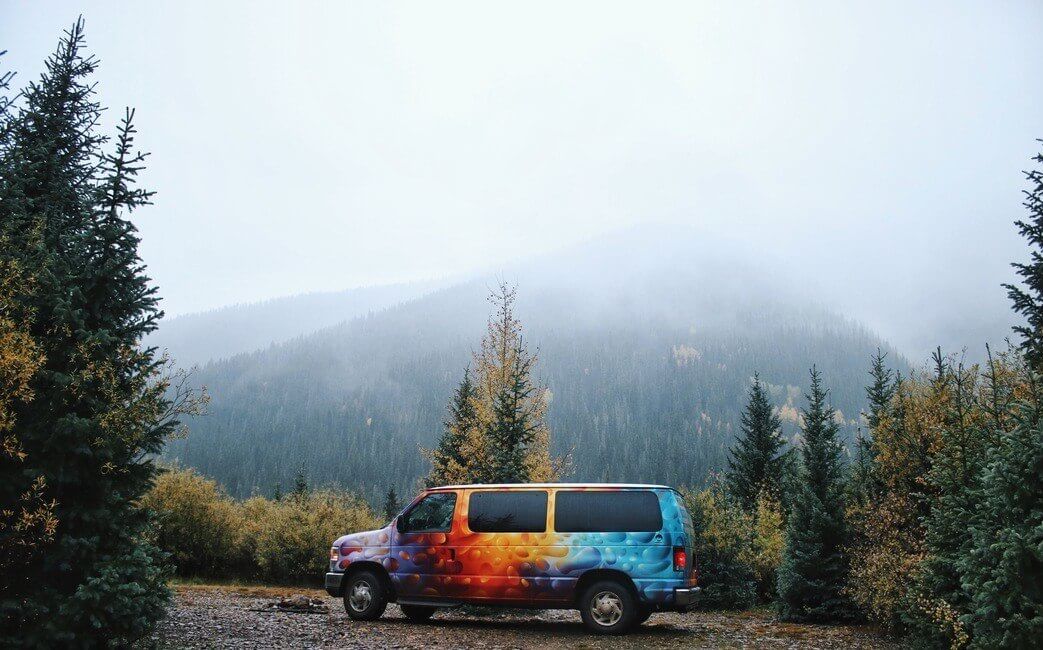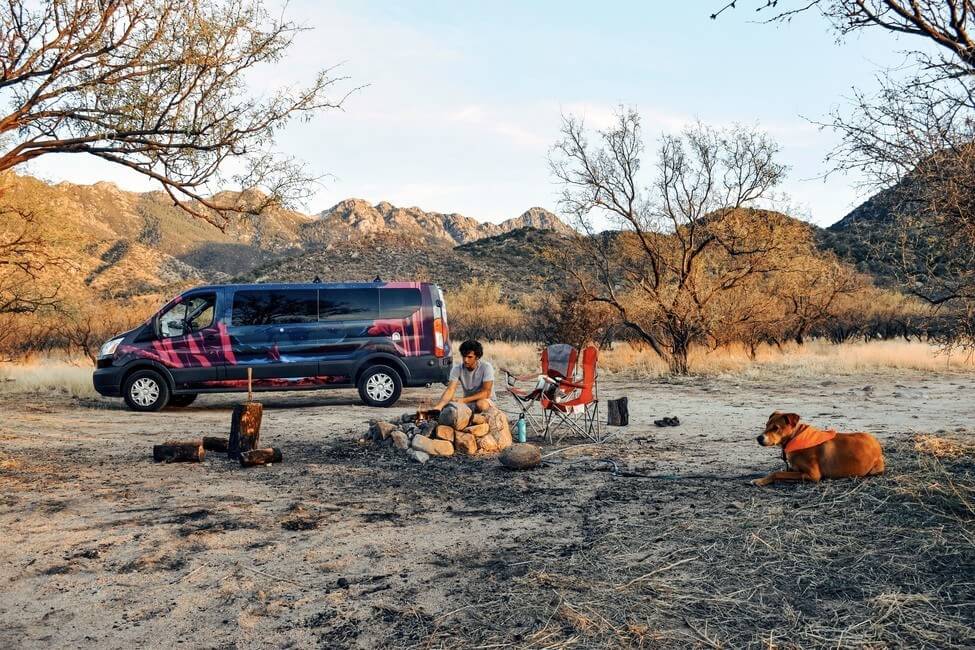We once had a lovely German couple rent a campervan for 110 nights and they (legally) didn’t pay for a single campsite. True story. How? Dispersed camping! If you’re looking for a free, one-of-a-kind wilderness experience away from other people, dispersed camping is for you.
Continue reading to learn what dispersed camping is all about, how it works, and how to find dispersed camping sites:
What is dispersed camping?
Dispersed camping, also known as free camping, pirate camping, boondocking, or just plain roughing it, is camping outside of designated campground areas on Forest Service Land. It’s perfect for those looking to save on campground fees and enjoy nature without neighbors.
Unlike pay campsites in national, state, and RV parks, dispersed campsites offer few of the amenities you’d typically expect like toilets, showers, adjacent restaurants, etc (think middle of nowhere). What you do get in lieu of these luxuries are very few neighbors, a canopy of stars, the wind in the trees, and the satisfaction of knowing you’ve finally made it off the beaten track.
What is primitive camping? Is it the same as dispersed camping?
Primitive camping is backcountry camping in remote areas without amenities like bathrooms, picnic tables, trash cans, or any other man-made structures. Dispersed camping and primitive camping are often used interchangeably but primitive campers usually leave the car behind in favor of hiking, biking, or some other non-gas powered mode of transportation. Both forms of camping offer similar benefits but one can be accessed by car (four wheel drive is recommended) while the other requires a little more effort.
Is dispersed camping free?
Yes, dispersed camping is free and does not require reservations beforehand. Simply find a suitable spot and set up camp. Make sure to consult a map before heading out to make sure dispersed camping is allowed in the area would like to go to.
Read our guide on how to find free camping to learn more about other types of free camping and where to find them.
How do I know what’s legal?
Look at a Forest Service map specific to the state you want to stay in and you’ll see areas designated as National Forest or Bureau of Land Management land. Within these areas, it’s (usually) legal to car-camp for FREE! Remember this as it’ll save you big $$$ during your road trip. The United States is peppered with federally-owned land, comprising roughly 28 percent of the entire country (and about half is in the West).
Look out for posted signage, such as “no overnight parking” and “day use only.” If you see one of those, we recommend you find another place to camp. Always check with a ranger to confirm which areas are and are not legal when you arrive. Know before you go!
Where you can camp:
Unless stated otherwise (always check with a ranger), it’s legal to sleep in your vehicle within ANY federally designated lands. These include:
- National Forests
- Bureau of Land Management (BLM)
- Wildlife Management Areas (WMA)
- National Grasslands
- Some County Parks & City Parks – Check signs
- Some trailheads – Check signs
- Closer to civilization: Parking lots and truck stops
Look for the (usually) brown and yellow signs announcing your entrance to public land and you’ll know you’re in the right place. Be aware of wildfires during the warmer months in California and surrounding areas when planning your trip – camping is not permitted when there are active wildfires in the area.
How to find dispersed camping sites?
Dispersed camping sites are definitely not all made equally. Sometimes the question isn’t “Can I camp here?” but more “Should I camp here?”. Some places you may be able to camp at could lead to a miserable time if they aren’t suitable for how you like to camp. To make it easier to find a dispersed camping site, follow these tips:
- Ask a ranger. For an inside track into the best places to stay, keep an eye out for any BLM Ranger Station or visitor center and ask the true locals (Rangers) for their suggestions. We’ve never been led astray and you’ll be amazed at how much they’ll go out of their way to help you out.
- Scour Google Maps. Again, look for the green areas that signify public lands. Use Google Earth to get an idea of roads and landscapes.
- Attempt to camp close by a paved road. If not possible, camp near a bare, well-packed gravel track. Note that this is done at your own risk: if renting an Escape Campervan, you are NOT covered by insurance and are NOT covered in the Escape Roadside Assistance plan if you are OFF a paved road. Camping on a level area also makes sleeping more comfortable.
- If you’re going to an area where others have camped before, pick a site that has been used before. Plants, soil, and wildlife are impacted by new campsites so using existing ones will minimize your impact on the forest. Always follow Leave No Trace principles.
- Check out these online resources and apps that make it easy to find places to camp:
- If all else fails, find a Walmart or a truck stop. Free camping isn’t solely limited to Federal Lands. Walmart parking lots, truck stops, and rest areas can also make for serviceable and convenient places to park for the night. Remember to check the signs first to make sure you can stay there overnight.
Dispersed camping rules of the road
There are extra responsibilities and skills that are necessary for dispersed camping. It is your responsibility to know these before you try this new experience.
- Contact the local Forest Service office to see if any restrictions (especially fire restrictions) are in place. This includes finding out if campfires and open stoves are permitted – in much of the West, drought conditions are severe and no flames of any sort are allowed. Ground tents are occasionally not allowed on federal lands or at rest stops (good thing you’ll be in a campervan!). There is also usually a 14-day limit on staying at the same campsite within a 30-day period.
- Leave it better than you found it. Pack out everything you brought in, including trash. “LEAVE NO TRACE” is the official guideline. Brush up on your LNT knowledge. Dispersed camping means there are likely no bathrooms in the area. To dispose of urine, etc. while you wild camp, dig a hole six inches (15 cm) in the ground at least 100 feet away from any water source. When you are done, fill the hole with dirt and take toilet paper with you. Really. Used toilet paper can, and will, pollute local water sources. Or, just commit to nature and find a big soft leaf to use!
- Dispersed camping is allowed in a one-mile perimeter away from campgrounds and 100 feet from any stream.
- Don’t sleep on the side of the road – it’s usually illegal. To prevent resource damage, keep your campsite within 150 feet from a roadway.
- Bring plenty of your own water, or have a way to treat it. Just because you found a campsite near a stream or river with seemingly nothing else around doesn’t mean the water is safe to drink. Always treat the water you get from natural sources so that you don’t have to end your trip early!
- Be prepared. Bring a good atlas and/or GPS to help you find your way in/out of the woods (try to arrive early with plenty of daylight to find a campsite for this reason). Check the weather for rain, which can create mud holes that you can’t drive out of.
- Use your judgment – if the campsite feels unsafe, move on.
- Be bear aware. If you’re in bear country (and we highly recommend finding this out prior to camping there), store food and other scented items in a bear canister or outside of your vehicle overnight. Read more about wildlife safety here.
- There are usually no fees for dispersed camping, but not always. If there are fees, it’ll probably be around $5-$10.
- Be sure to check for any signs that may prohibit overnight parking.
3 reasons why campervans are perfect for dispersed camping:
If you’ve never tried out van life before, you may have concerns about how to find places to camp–especially during the busy summer months when many public and private campsites have been booked since January. The beauty of traveling by camper van is that finding camping can actually be pretty easy (if you know where to look!). With a campervan, you can:
- Fit into most standard tent sites. These are significantly cheaper than RV sites and there are often more of them available. You always have the option to splurge for a utility site with an electric hook-up or a larger RV site with all the bells and whistles, but you don’t have to. When in doubt, always double-check with the folks who run each individual campground. You can find out the length of each campervan model if required.
- Easily navigate side roads. Scoping out the perfect campsite is easier in a campervan because you can drive down small, windy roads that RVs can’t access. No stress! Just be aware that this is at your own risk–insurance only covers you on state- and county-maintained roads.
- Find FREE dispersed camping almost anywhere you go! Dispersed camping is one of America’s best-kept secrets. There are a few important guidelines to follow, but once you get the hang of it you’ll find that not only is it free, but it’s also fun and easier than you might expect. You’ll never look back!
Going to Canada? Dispersed camping regulations are different here than in the US. Check out our Guide to Dispersed Camping in Canada.
Ready to try dispersed camping?
If you follow the guidelines above, you can save a safe, low-impact, primitive camping experience away from all the crowds for FREE. Check out our blog for more helpful guides and tips like when to book national park campsites or the best time to see waterfalls in Yosemite.
If you’re ready to try out free dispersed camping, don’t forget to book your camper van rental at one of our many US or Canada locations. Contact us directly if you have any questions.


 Call Us
Call Us



